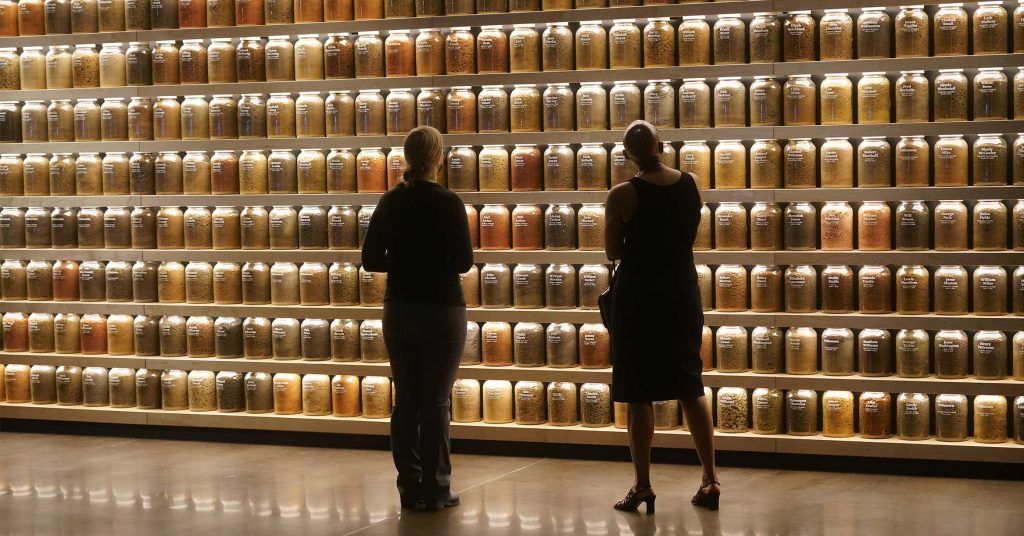Can something horrible be made beautiful? It’s a question that came to mind after Roberta and I recently visited The Legacy Museum in Montgomery, Alabama, a project of the Equal Justice Initiative (EJI). EJI is a non-profit organization founded in 1989 to provide legal representation to prisoners who may have been wrongly convicted of crimes, poor prisoners without effective representation, and others who were denied a fair trial. It guarantees the defense of anyone in Alabama in a death penalty case. Through the efforts of EJI’s attorneys, several persons wrongfully convicted have been exonerated of the crimes of which they were accused.
A memorial project began in 2018, and EJI now has three memorials in Montgomery to the victims of slavery and racial violence: The Legacy Museum, The National Memorial for Peace and Justice (commonly known as the Lynching Memorial, as it lists the names of all known lynching victims), and, open for the past three months, The Freedom Monument Sculpture Park.
A visit to any of those sites is a moving experience, but I want to talk here about The Legacy Museum. More of a historical museum than an art museum (though it does have a gallery exhibiting the works of Black artists responding to racial injustice), the museum uses a variety of media to record history of slavery: interactive maps showing the routes of slave ships from Africa to the Americas, slave holding cells inhabited by holograms of actors in the roles of enslaved persons who describe their ordeals during the Middle Passage, transcriptions of the accounts of Black families being separated for sale, images of lynchings, and photographs of Birmingham police using fire hoses and police dogs against persons demonstrating for voting rights and an end to segregation.
Horrific subjects, to be sure, and appropriately ugly. But there was one exhibit that started the critic in me percolating.

Photo courtesy Equal Justice Initiative, Community Remembrance Project
It is a wall of one-gallon storage jars, 800 of them, stacked back-to-back, making the wall two jars deep. Each jar contains soil taken from the site of a lynching that took place over the century following the Civil War. Affixed to the front of each jar is a label with the name of the victim, plus the date and place of the lynching. Each side of the memorial wall is lit, and shelf lights catch all sides of the jars, emphasizing their three-dimensionality and making them almost glow, like spices on a giant spice rack or the healing ingredients on the shelves of an apothecary. Coming after horrific scenes of racial violence, these literal earth-tones are calming.
Ever the art critic, however, I found myself wondering about the placement of the jars. They’re not organized by victim’s name, place of murder, date, or the color of the jars’ soil. How, then, were the jars placed? I spoke with a spokeswoman for the Equal Justice Initiative, who informed me that the 800 jars on display were only a portion of the jars the Community Remembrance Project has collected. The jars on view are replaced by others from time to time to give each victim his or her chance to be remembered, and any attempt to re-order the exhibit each time a jar is exchanged would be an impossible task. The jars are replaced at random, with no consideration given to the overall visual impact. The piece is simply a memorial, not a work of art.
And yet, decisions were made that pull the memorial into something approaching art. The size of the jars, for example – each jar is the largest size, one gallon, that is easily handled by the average person. If this piece were simply a memorial, half-pint jars of soil could fulfil the symbolic purpose. Furthermore, the jars in the memorial are placed on shelves to make up a wall. Imagine if the memorial were composed of half-pint jars placed in the drawers of cabinets. Pulling out drawer after drawer, each containing, say, 50 jars with labels pasted to their lids might be a sobering or a horrifying experience, but the experience would lack the jolt of beauty that the actual installation delivers.
Perhaps it is wrong to consider the wall in an aesthetic sense, but I can’t help doing so, and, oddly, having beauty wedded to the evil helps ensure that remembrance lasts. Two months after my visit to the museum, I can only vaguely remember the slave ship routes, the statistics of the slave sales, or the newspaper headlines of stories detailing attacks on Freedom Riders. Yet the memory of that lovely wall, composed of blocks of color remains and, with it, the knowledge that each of the 800 jars on view memorializes someone who died in a horrible fashion. My people did this to them.
Slaughter, executions, and aerial bombings have found their way into the art of Goya, Manet, Picasso, and dozens of other artists. We may be appalled by the scenes, but the artist’s accomplishment does not permit us to look away. In the words of Yeats, a terrible beauty is born.

